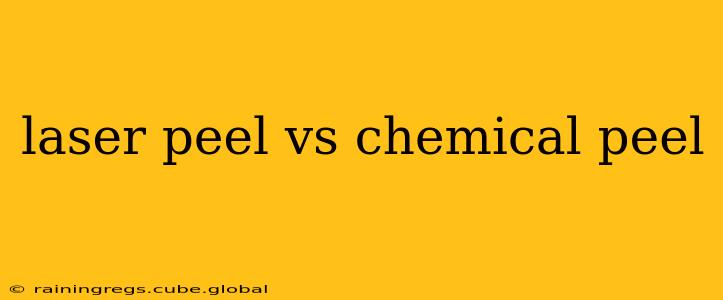Choosing between a laser peel and a chemical peel can feel overwhelming. Both treatments aim to rejuvenate the skin, improving texture, tone, and reducing the appearance of wrinkles and blemishes. However, they achieve this through different mechanisms, making them suitable for different skin types and concerns. This comprehensive guide will break down the key differences, helping you make an informed decision.
What is a Laser Peel?
A laser peel uses a high-intensity laser beam to precisely remove the outer layers of skin. The laser's heat stimulates collagen production, leading to firmer, smoother skin. Different types of lasers offer varying depths of peel, ranging from superficial to deep resurfacing. This allows for customization based on individual needs and skin conditions.
What is a Chemical Peel?
A chemical peel uses a chemical solution to exfoliate the skin. The strength of the solution determines the depth of the peel, ranging from light peels targeting superficial concerns to deep peels addressing more significant issues like deep wrinkles and scarring. Common chemical peel solutions include alpha-hydroxy acids (AHAs), beta-hydroxy acids (BHAs), and trichloroacetic acid (TCA).
Laser Peel vs. Chemical Peel: Key Differences
| Feature | Laser Peel | Chemical Peel |
|---|---|---|
| Mechanism | Laser energy removes skin layers | Chemical solution exfoliates skin layers |
| Precision | Highly precise targeting | Less precise targeting |
| Depth of Peel | Superficial to deep resurfacing available | Superficial to deep peeling available |
| Recovery Time | Generally longer, depending on depth | Varies significantly based on peel depth |
| Cost | Typically more expensive | Generally less expensive |
| Suitable for | Wrinkles, scars, acne scars, sun damage | Wrinkles, acne, uneven skin tone, age spots |
What are the benefits of a laser peel?
Laser peels offer several benefits:
- Precise targeting: The laser can target specific areas, minimizing damage to surrounding skin.
- Improved collagen production: The heat stimulates collagen and elastin regeneration, leading to firmer and smoother skin.
- Effective for various concerns: Treats wrinkles, acne scars, sun damage, and other skin imperfections.
- Potential for deeper resurfacing: Allows for more aggressive treatment of severe skin damage.
What are the benefits of a chemical peel?
Chemical peels also provide numerous advantages:
- Relatively less expensive: Compared to laser peels, chemical peels are often more affordable.
- Less downtime (for lighter peels): Lighter chemical peels offer shorter recovery periods.
- Improved skin texture and tone: Effectively addresses uneven skin tone, acne, and fine lines.
- Variety of solutions: Different chemical solutions cater to various skin types and concerns.
How long is the recovery time for each procedure?
Recovery Time: This varies greatly depending on the depth of the peel for both procedures. Superficial peels of either type may involve minimal downtime, with redness subsiding within a few days. Deeper peels, however, can result in several weeks of downtime with significant redness, swelling, and peeling. Your dermatologist will discuss expected recovery time based on your specific treatment plan.
Which procedure is better for acne scars?
Both laser peels and chemical peels can improve the appearance of acne scars, but the best choice depends on the severity of the scarring. For deep, pitted scars, a laser peel, particularly fractional laser resurfacing, is often more effective. Milder acne scarring may respond well to a medium-depth chemical peel.
Which procedure is better for wrinkles?
Again, both procedures can address wrinkles, but the depth of the wrinkles and the desired level of improvement will influence the choice. For moderate to deep wrinkles, a laser peel may be preferred for more significant collagen stimulation and resurfacing. Superficial wrinkles might respond well to a lighter chemical peel.
Which procedure is better for sensitive skin?
Individuals with sensitive skin may find lighter chemical peels more tolerable than aggressive laser treatments. A consultation with a dermatologist is crucial to determine the best and safest approach for sensitive skin.
What are the risks and side effects?
Both laser peels and chemical peels carry potential risks, including:
- Infection: Proper post-procedure care is essential to minimize the risk of infection.
- Pigmentation changes: Hypopigmentation (loss of pigment) or hyperpigmentation (increased pigment) can occur, particularly in individuals with darker skin tones.
- Scarring: Although rare, scarring is a potential risk, especially with deeper peels.
- Allergic reactions: Chemical peels may trigger allergic reactions in sensitive individuals.
Disclaimer: This information is for educational purposes only and does not constitute medical advice. Always consult a qualified dermatologist or medical professional to determine the best treatment option for your specific skin type and concerns. They will assess your skin, discuss your goals, and recommend the most appropriate procedure with a personalized approach.
